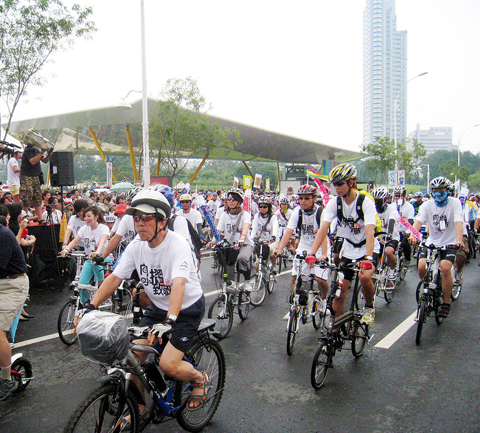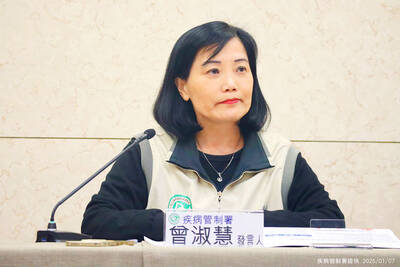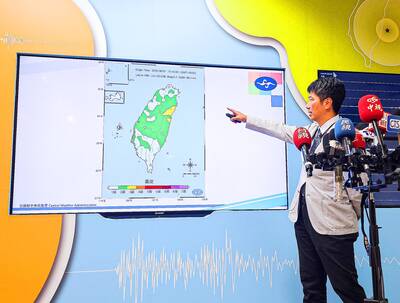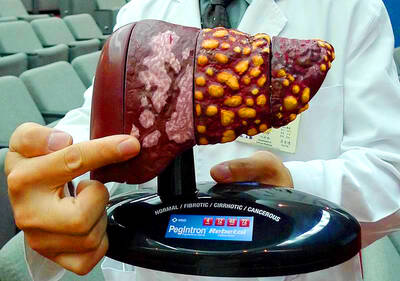At an Aug. 2 bicycling event in Kaohsiung, Bai Yue, in his 20s, described one important benefit he’d received from engaging in the activity: a new girlfriend. Bai met the young woman, Tzi Lin, through a folding bike blog, and they began going on dates together to biking events.
Now, the two are a couple. Both attended the Kaohsiung event, where more than 5,000 people turned out to tour two new bicycle paths.
Bai and Lin are among an estimated 600,000 bicycling enthusiasts nationwide, nearly double the 330,000 in 2006, a recent report released by the Council for Economic Planning and Development showed. Bicycle sales have shot up, as Taiwanese flock to enjoy the health and recreational benefits of the sport.

PHOTO: CNA
The fad has gotten a further boost with skyrocketing fuel prices, which have made bicycles an attractive, cheaper option to traveling by car or scooter.
Now, with Taiwan’s love affair with the bicycle in full bloom, cities and counties are scrambling to meet cyclists’ demands for more racks, bike paths and dedicated lanes on city streets. But cyclists say more needs to be done — especially in the area of safety — to make Taiwan a truly bicycle-friendly nation.
In a survey conducted by the Chinese Cultural University earlier in the year, cyclists described bicycles as being a “symbol of freedom, “helping conserve energy, reduce pollution and the number of cars on the road, and promote physical fitness.”
The growing popularity of recreational cycling can be seen in the many bicycle tour events in the past few months — such as Kaohsiung’s folding bike event in May — which now attract hundreds or even thousands of people. A survey released by the Taipei City Government earlier this month showed that the number of city residents who ride bikes increased to 10.5 percent of the population last month, up from 6 percent in May. The city expects that if fuel prices increase another 30 percent, ridership will further rise to 16.5 percent.
Capitalizing on the current bicycle fad, Taiwan’s Giant Inc, the largest domestic bicycle manufacturer, sold 140,000 bikes in Taiwan in the first half of the year, 40 percent more than in the same period last year.
The company’s revenue for the first half of this year soared 60 percent to NT$1 billion (US$32 million) , company spokeswoman Irene Chen (陳美惠) said.
She said that Giant expects the number of cyclists to continue growing, hitting some 700,000 by the end of the year.
Governments are trying to keep up with the challenges presented by the surging number of bicyclists demanding better facilities and rights. The central government announced a plan on Aug. 7 to add more dedicated lanes alongside major city streets nationwide to better meet cyclists’ needs.
The plan has already sparked complaints from motorcyclists, who already dodge cars, trucks and buses in heavy traffic on roads like Taipei City’s Dunhua Road.
Chen Chin-pi, 45, a white-collar employee who commutes daily by scooter from Zhonghe (中和) to his office in downtown Taipei, said there are more motorcyclists than bicyclists in the country, and that the government should protect motorcyclists’ rights, too.
Chen suggested that the government develop more bike routes rather than adding bike paths, which will take away space from already-crowded traffic lanes.
The controversial bike-lane plan comes after local governments have already added hundreds of kilometers of new bicycle trails, and thousands of new bicycle racks.
By the end of last year, the central government had built 40 dedicated bicycle paths totaling more than 1,180km. It hopes to build a total of 2,600km of paths by 2011.
Taipei City and Taipei County now have more than 500km of dedicated bike paths. Taipei City provides 16,000 racks for parking bicycles, including 1,100 double-decker racks outside MRT stations. The city hopes to add bike parking with lockers to further help cyclists.
Kaohsiung City now has more than 100km of bike trails, and hopes to have a total of 180km built before the opening of the World Games in Kaohsiung next summer.
With the cycling boom, concerns about more accidents have emerged.
A survey commissioned by the Department of Health showed that every year sees an average of 3,700 injuries from cyclists, with 3 percent to 5 percent of them fatal.
It’s not yet clear to what extent such mishaps are on the rise with the nationwide fad, but Tainan City statistics showed bicycle accidents there spiking 24.4 percent in the first half of this year as compared with the same period last year.
The health department survey showed that the main cause of accidents was cyclist error, chiefly not yielding right-of-way to motorists or disobeying other traffic rules. Poor road design and bad visibility at night were also cited as main causes.
To keep accident numbers down, cyclists suggested in a recent interview that the government create more dedicated bike lanes, as are already planned in Taipei, Kaohsiung and Taichung.
David Reid, in his 30s, a cycling enthusiast and Taipei County resident, said there are plenty of recreational bicycle paths outside city centers, but that doesn’t solve the problems many city commuters face. The government should enact policies to reduce cars on the road, he said, but did not give details.
However, Chang Ming-yuan, a 42-year-old cyclist, said the goal could be reached by pushing forward car-sharing schemes — sharing a ride with a colleague at work or rotating with other parents on school runs — or designating a national car-free day.
Some cyclists also suggested that the government require all bicycles sold in Taiwan to meet higher safety requirements — for example, by requiring that all bicycles have both front and rear reflectors. They also advised the government to better enforce traffic rules and promote awareness of proper road use among cyclists.
For example, all cyclists are supposed to ride the same direction as traffic, and use hand signals to indicate when they are slowing, stopping or turning.
Cyclists also emphasized that all riders should wear helmets, to prevent sometimes fatal head injuries resulting from bicycle accidents.

The Taipei Summer Festival is to begin tomorrow at Dadaocheng Wharf (大稻埕), featuring four themed firework shows and five live music performances throughout the month, the Taipei Department of Information and Tourism said today. The festival in the city’s Datong District (大同) is to run until Aug. 30, holding firework displays on Wednesdays and the final Saturday of the event. The first show is scheduled for tomorrow, followed by Aug. 13, 20 and 30. To celebrate the 30th anniversary of Disney Pixar's movie Toy Story, the festival has partnered with Walt Disney Co (Taiwan) to host a special themed area on

BE CAREFUL: The virus rarely causes severe illness or death, but newborns, older people and those with medical conditions are at risk of more severe illness As more than 7,000 cases of chikungunya fever have been reported in China’s Guangdong Province this year, including 2,892 new cases last week, the Centers for Disease Control (CDC) yesterday said it is monitoring the situation and considering raising the travel notice level, which might be announced today. The CDC issued a level 1 travel notice, or “watch,” for Guangdong Province on July 22, citing an outbreak in Foshan, a manufacturing hub in the south of the province, that was reported early last month. Between July 27 and Saturday, the province reported 2,892 new cases of chikungunya, reaching a total of 7,716

Aftershocks from a magnitude 6.2 earthquake that struck off Yilan County at 3:45pm yesterday could reach a magnitude of 5 to 5.5, the Central Weather Administration (CWA) said. Seismological Center technical officer Chiu Chun-ta (邱俊達) told a news conference that the epicenter of the temblor was more than 100km from Taiwan. Although predicted to measure between magnitude 5 and 5.5, the aftershocks would reach an intensity of 1 on Taiwan’s 7-tier scale, which gauges the actual effect of an earthquake, he said. The earthquake lasted longer in Taipei because the city is in a basin, he said. The quake’s epicenter was about 128.9km east-southeast

STAY VIGILANT: People should reduce the risk of chronic liver inflammation by avoiding excessive alcohol consumption, smoking and eating pickled foods, the physician said A doctor last week urged people to look for five key warning signs of acute liver failure after popular producer-turned-entertainer Shen Yu-lin (沈玉琳) was reportedly admitted to an intensive care unit for fulminant hepatitis. Fulminant hepatitis is the rapid and massive death of liver cells, impairing the organ’s detoxification, metabolic, protein synthesis and bile production functions, which if left untreated has a mortality rate as high as 80 percent, according to the Web site of Advancing Clinical Treatment of Liver Disease, an international organization focused on liver disease prevention and treatment. People with hepatitis B or C are at higher risk of